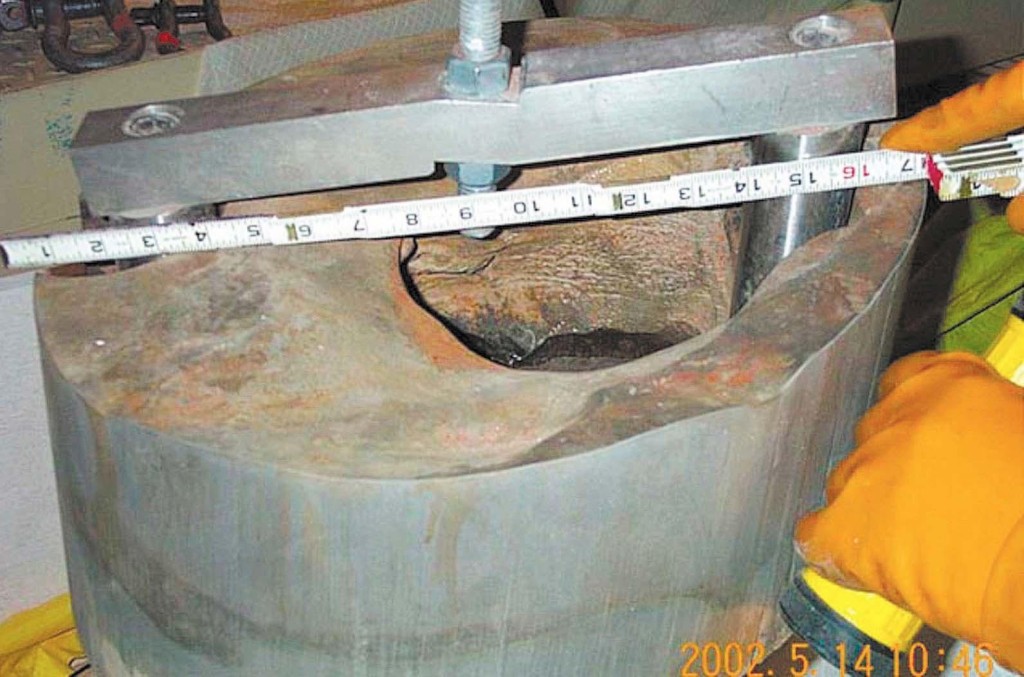 Section of Davis-Besse reactor pressure vessel head that was harvested for study of extensive corrosion and " hole-in the head."Beyond Nuclear and two New Jersey groups (Clean Water Action NJ and GRAMMES) have called on the U.S. Nuclear Regulatory Commission (NRC) and Exelon Generation to conduct an “autopsy” on the Oyster Creek once the nation’s oldest operating nuclear power station permanently closes in October 2018. During Oyster Creek's decommissioning process, the groups want the federal regulator to oversee a “strategic harvest” of materials from the reactor's safety systems, structures and components to gather observable and measureable scientific data on the effects of aging on the 47-year old reactor.
Section of Davis-Besse reactor pressure vessel head that was harvested for study of extensive corrosion and " hole-in the head."Beyond Nuclear and two New Jersey groups (Clean Water Action NJ and GRAMMES) have called on the U.S. Nuclear Regulatory Commission (NRC) and Exelon Generation to conduct an “autopsy” on the Oyster Creek once the nation’s oldest operating nuclear power station permanently closes in October 2018. During Oyster Creek's decommissioning process, the groups want the federal regulator to oversee a “strategic harvest” of materials from the reactor's safety systems, structures and components to gather observable and measureable scientific data on the effects of aging on the 47-year old reactor.
The operational environment of a nuclear power station is very harsh involving the prolonged exposure of materials to extremely high pressure and temperatures, the bombardment with radiation, vibration, fatigue and corrosion. Oyster Creek is the first operational GE Mark 1 boiling water reactor in the U.S. fleet of 21 similarly designed reactors still in operation. Oyster Creek's GE design is identical to Japan’s now destroyed Fukushima Daiichi nuclear reactors. The groups assert that an autopsy needs be performed on permanently closed nuclear power plants to collect samples of irradiated steel and concrete from safety-related components and structures for laboratory analysis of the effects of aging on those reactors still operating.
To date surprising few laboratory samples and archival material has been harvested from closed U.S. reactors. The Zion nuclear power station in Illinois has harvested samples from the reactor pressure vessel and the Crystal River nuclear power in Florida has provided sections of electrical cable to scientifically exam and measure the effects of aging on safety-related materials to gain insight on residual safety margins and how that relates to similar materials in reactors still operating. For example, samples can be taken from Oyster Creek and then analyzed to better access the material condition of another Exelon Generation still operating GE Mark I reactor, Peach Bottom, that extend power operations out to 80 years.
The NRC gave a presentation in 2015 that attributes the present dearth of scientific data points the effects of aging on the lack of reactor sites undergoing decommissioning. Presently, 10 reactor units in the US have completed decommissioning and 20 additional units are in process and potentially for decades yet to come. That same presentation states that in anticipation of strategically harvesting safety-related samples from nuclear power stations, the NRC has already prepared a list of 3863 components (2203 from pressurized water reactors and 1603 from boiling water reactors) for the analysis of 16 different age-related degradation mechanisms.
However, the industry has been reluctant to cooperate with NRC requests for voluntary harvesting. One criticial opportunity arose in the 1990's when the Yankee Rowe nuclear power station in Massachusetts permanently closed with the discovery of a severely embrittled reactor pressure vessel. During decommissioning, Yankee Atomic Power Corporation declined a request from NRC staff to harvest metal samples from the reactor pressure vessel wall for analysis on embrittlement. Instead, Yankee Atomic decommissioned the reactor, filled the vessel with nuclear waste and low-density concrete and shipped it whole to Barnwell, SC for burial without providing a single sample.